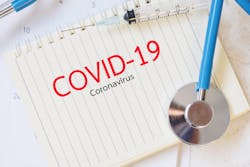ACOs Describe How Population Health Expertise Is Paying Off During Pandemic
In the wake of the pandemic, health systems have been forced to pivot quickly to redeploy personnel and other resources to support front-line clinicians and reach out to vulnerable populations. During a recent panel discussion, three executives discussed how their experience with value-based care models made them nimble enough to respond.
Speaking during the spring meeting of the National Association of ACOs, Mike Hebert, R.N., M.S.N., M.B.A., senior director UM (utilization management) of care management and geriatrics for Massachusetts-based Reliant Medical Group, noted that earlier work the multispecialty group practice did pre-COVID paid off when the emergency struck.
Reliant has established referral management teams and on-site population health resources embedded in primary care sites, with nurse case managers, social workers and care coordinators to help fill gaps in care. They also have taken steps to ensure smooth transitions of care with skilled nursing facilities. “The biggest benefit is having everything under one roof,” he said. Optimizing work flows can be difficult in some settings, Hebert added. Having the infrastructure built the way it is allows Reliant to be efficient when it takes on a new payer or model or wants to change how it does something.
Despite their flexibility, Reliant was not planning on something like COVID, so it had to act fast. One redeployment involved its referral management team with 45 full-time-equivalent employees. Because of the pandemic, they were not seeing the same volume of referrals, but rather than furlough some of them, Reliant redeployed some of the to do outreach to do check-ins with patients with chronic conditions. This allowed them to make sure patients were clear about COVID safety precautions. Another group of health coordinators, whose full-time job is closing gaps in care switched to addressing emerging behavioral health needs. “As calls were made, we found a swell of behavioral health need emerging,” Hebert said. “We had resources available and could facilitate community connections.
Patients seem to have a true appreciation for the outreach calls, he said. It has built patient engagement and intensified loyalty.
Hebert said they also worked to reduce or shift population health management staff to maintain a constant presence for patients. “We had the fortunate ability to rotate schedules, and prioritize staff safety without sacrificing quality of case management.”
Care teams also moved to telephonic and/or visits, and stood up testing tents all while continuing to treat patients in need.
Banner Health
Ed Clarke, M.D., is chief medical officer, of the Insurance Division and Banner Health Network of Banner Health in Arizona, where the pandemic is flaring up now. He spoke about several initiatives that were repurposed or expanded for COVID.
For instance, in the behavioral health realm, Banner had relationship with a mobile app develop called Pyx that had been used primarily in the Medicaid population to address loneliness and isolation. “Since we were telling patients to isolate, we thought why don’t we use this for other lines of business, so we are expanding the contract for commercial members, and since then the average age of enrollees is 73,” he said.
Another area of focus that was enhanced was clinician well-being, Clarke said Banner Health Chief Clinical Officer Marjorie Bessel, M.D., had already done work on a multi-year strategy to support physician and other provider well-being called Cultivating Happiness in Medicine. It has modules for stress management and for leading a team during crisis. That was expanded with group coaching calls led by physicians and the offer of individual counseling.
Executives on Clarke’s team started interacting with payers in new ways. Once per week, they have been holding calls with 80 payer leaders to let them know what Banner is doing in terms of things like bed capacity and help nudge them to keep certain waivers in place.
Over 90 percent of the clinically integrated network stood up telemedicine capabilities within one week, he said. In addition, clinical performance reviews with physician practices were made virtual. “The adoption of virtual visits was not only for patients but also for how we work with the network,” Clarke said. Practice leaders have actually found that they like doing the clinical performance review meetings remotely, he said. “Some of them said the virtual meeting was so much easier for them and asked if we could do this all the time.” He added that remote EHR access for Banner’s “audit” team has skyrocketed.
Mount Carmel Health Partners
Tricia Wise, R.N., M.B.A., director of population health at Mount Carmel Health Partners in Columbus, Ohio, said one of the lessons learned from the pandemic is that “organizations without population health efforts were in trouble. We are thankful we have a diverse multidisciplinary team to do all kinds of deployments.”
She said that pre-COVID, her organization had done a lot of work on improving post-acute care transitions. Her team had hired a post-acute manager who created a preferred SNF network based on quality metrics. She developed a scorecard shared with the network and held SNF town halls with providers on specific topics such as sepsis. Mount Carmel is also launching a “hospital at home” initiative to treat more patients in the home setting. Nurses talk to patient on the phone and if something doesn’t sound right, they dispatch a home health nurse within two hours. That nurse calls in to a nurse line with an assessment, so they can get providers to do an intervention to avoid an ED visit if that is not what the patient needs.
When the pandemic struck, Mount Carmel shifted personnel to do proactive outreach to its most vulnerable population for scheduling virtual or in-person visits. Pharmacy staff began doing outreach to ensure that patients had enough medications
The health system began proactive outreach by social workers for patients with elevated PHQ-9 (depression) scores on screenings. The health system also implemented a suicide risk assessment protocol in the care management setting. The pandemic has “increased awareness and openness to discussing mental health,” Wise said.
Mount Carmel also expanded a program it had begun to collaborate with community paramedics on transportation. For instance, recently an elderly couple needed labs drawn but were scared to go out. Mount Carmel worked with paramedic in their area to get the labs drawn. “It is a good partnership,” Wise said. “It keeps people safe and at home if possible.”


